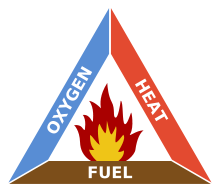8th Grade > Chemistry
COMBUSTION AND FLAME MCQs
Total Questions : 56
| Page 3 of 6 pages
Answer: Option B. -> False
:
B
Smoke and flame are produced due to different reasons.
Aflame is produced when the gases released when a fuel is burnt are combustible. These gases then catch fire which we see as a flame.
Smoke is a result of partial combustion or some leftover unburnt particles. These tiny, unburnt particles get released into the air alongwith the gases of combustion and get mixed with the air which we see as smoke.
These two things can happen independently and thus occurence of one event does not guaranteethe occurence of other.
:
B
Smoke and flame are produced due to different reasons.
Aflame is produced when the gases released when a fuel is burnt are combustible. These gases then catch fire which we see as a flame.
Smoke is a result of partial combustion or some leftover unburnt particles. These tiny, unburnt particles get released into the air alongwith the gases of combustion and get mixed with the air which we see as smoke.
These two things can happen independently and thus occurence of one event does not guaranteethe occurence of other.
Answer: Option A. -> calorific value
:
A
Fuel efficiency isexpressed in terms of calorific value and its unit iskilojoule per kg. It is the amount of heat produced on complete combustion of 1kg of a fuel.
:
A
Fuel efficiency isexpressed in terms of calorific value and its unit iskilojoule per kg. It is the amount of heat produced on complete combustion of 1kg of a fuel.
Answer: Option B. -> False
:
B
Substances produce flames while burning, only if it vapourises during the process.
For example, molten wax risesthrough the wick and isvapourised during burning. So, theyform flames.
Charcoal, on the other hand, does not vaporise. So,it does not produce any flame.
Hence, the above statement is false.
:
B
Substances produce flames while burning, only if it vapourises during the process.
For example, molten wax risesthrough the wick and isvapourised during burning. So, theyform flames.
Charcoal, on the other hand, does not vaporise. So,it does not produce any flame.
Hence, the above statement is false.
Answer: Option A. -> Ash
:
A
Ash is the solid residue of a fuel. It is the material that is left unburnt at the end of combustion. Its chemical composition does not contain carbon.
:
A
Ash is the solid residue of a fuel. It is the material that is left unburnt at the end of combustion. Its chemical composition does not contain carbon.
Answer: Option D. -> Compressed Natural Gas (CNG)
:
D
There is probably no fuel that could be considered as an ideal fuel. We should look for a fuel which fulfils most of the requirements for a particularuse. Compressed Natural Gas (CNG) contains methane which doesn't produce a large amount of toxicgases or residue that pollute the environment. It is also easily combustible.Of the given options it is closest to being an ideal fuel.
:
D
There is probably no fuel that could be considered as an ideal fuel. We should look for a fuel which fulfils most of the requirements for a particularuse. Compressed Natural Gas (CNG) contains methane which doesn't produce a large amount of toxicgases or residue that pollute the environment. It is also easily combustible.Of the given options it is closest to being an ideal fuel.
Answer: Option B. ->
False
:
B
The lowest temperature at which a substance catches fire is its ignition temperature. The ignition temperature of kerosene is about 600C. Hence, it does not catch fire by itself at room temperature.
:
B
The lowest temperature at which a substance catches fire is its ignition temperature. The ignition temperature of kerosene is about 600C. Hence, it does not catch fire by itself at room temperature.
Answer: Option B. ->
Ignition temperature should be above room temperature.
:
B
Ignition temperature is the lowest temperature at which a substance catches fire. If the ignition temperature of a fuel is lower than the room temperature, then it can catch fire very easily.
Therefore for an ideal fuel, the ignition temperature should be higher than the room temperature.
:
B
Ignition temperature is the lowest temperature at which a substance catches fire. If the ignition temperature of a fuel is lower than the room temperature, then it can catch fire very easily.
Therefore for an ideal fuel, the ignition temperature should be higher than the room temperature.
Answer: Option B. ->
Chemical process
:
B
:
B
Combustion refers to the process where a substance burns in the presence of oxygen, giving off heat and light in the process.
The way to recognize a chemical change is to check whether a new substance is being created or not. During combustion, the fuel reacts with oxygen to form some new gases. So, a new substance is definitely formed. So, combustion is a chemical change.
Answer: Option B. ->
False
:
B
Whenever there is some unburnt residue in the product gases, the particles diffuse light passing through them and we see it as smoke.
If oxygen supply is limited, it will result in unburnt suspended particles in product gases which do not get oxygen to react with. And when there are non-inflammable impurities, they too will not burn and will result in ash or suspended particles.
:
B
Whenever there is some unburnt residue in the product gases, the particles diffuse light passing through them and we see it as smoke.
If oxygen supply is limited, it will result in unburnt suspended particles in product gases which do not get oxygen to react with. And when there are non-inflammable impurities, they too will not burn and will result in ash or suspended particles.

















